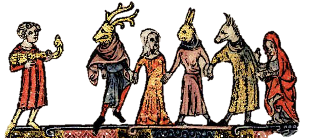A great feast, celebrated with family and friends, tables loaded with delicious food and sweet things, plenty of wine, houses decorated with boughs, the habit of giving each other gifts, sometimes singing songs together- of course I’m talking about the feast of … New Year!
Our New Year’s festivities have a long history and can be traced back to the Romans, where it was known as the Kalends. In the Roman calendars, the Kalendae are always the first day of the month. The Kalends of January therefore means the first of January and the start of the new Julian year. It was historically celebrated in Rome to mark the appointment of the new consuls for that year, with a public feast and a sacrifice to Janus, the god of the beginning and end, after whom the month was named. In the first centuries of the common era the Romans had conquered a large part of the Mediterranean region, and while they imposed their governors and administration on the whole Empire, they did not impose their own calendar on the provinces. Nevertheless, the Kalends of January festival became popular in the areas under Roman rule. This is striking, as many of the provinces had their own local calendars and their own New Year’s traditions, on a different day of the year.
In the provinces the Kalends appear to have been mainly an occasion for private feasts within the household, or possibly with extra guests, where gifts were sometimes exchanged. A particularly nice example is the following letter, from a girl called Therpe to her father, sent in Egypt sometime between the late fourth and fifth centuries:
‘To the master of my soul, truly the most esteemed, my father Theon, Therpe. Before anything I pray God the Almighty about your health. (…) Inform me so that I receive the leg ornaments so that I can wear them at the feast, because mine broke. Don’t I deserve the cakes and the spiced wine of the Kalends? You did not send me anything, not even a bit of money for the feast. Send D… so that she makes my himation. Do not forget the ornaments. I pray for your health for a long time, lord father.’ [1]
We see here that Therpe is looking forward to the delicacies and that she is eager to make a good impression at the feast itself. She complains almost petulantly about the lack of gifts from her father, so it is clear that these kinds of things were expected at the festival, at least in the higher classes, to which Therpe appears to belong.
A social gathering with a nice dinner and gifts, – what could possibly be wrong with that?
But some people disagreed. In the fourth century, Christianity became more and more dominant and church leaders grew more influential. When he was a priest in Antioch, the later archbishop of Constantinople John Chrysostom, for example, wrote about Christians participating – to his horror – in the Kalends festival. According to him, this was a ‘pagan’ festival, and celebrating it was an affront to the Christian faith, and very inappropriate for pious Christians. People shouldn’t give presents with the expectation to get a present in return, it was much better to give alms out of charity, without expecting anything back. Instead of indulging in food and drinks, fasting was the better option for ‘real’ Christians. The fact that he felt obliged to speak about these matters, however, proves that many Christians did participate in the festivities. Therpe was one of these. At the beginning of her letter she writes: ‘Before anything I pray God the Almighty about your health.’ This formula is an indication that she considered herself to be a Christian, but that didn’t stop her from celebrating the Kalends. The festival also survived in a purely Christian world; in later Islamic sources we find warnings for Muslims to stay away from the ‘Christian’ Kalends festival, which indicates that it was still celebrated by later Christians.
From other sources we learn that from the fourth century onwards, the festivities on the first of January became rowdier and wilder in Rome and the provinces. There is talk of masquerades in the streets, with people dressed up as animals, as a different gender or as the traditional gods, singing loudly until the early hours of the morning. Sometimes, children or adults were said to go by the houses, singing and asking for sweets or coins. To the modern observer, these are of course recognizable features, reminiscent of Carnival and Halloween, or in the Netherlands ‘Sint Martin’ in the north, and Three Kings Day in the south. In the Roman world, these rowdier elements had originally belonged to the Saturnalia, a festival celebrated in December – very close to January. The period between the old and the new year is sometimes portrayed as a grey area, an in-between zone, where the normal rules of society don’t apply, but a certain festive license reigns. This is still recognizable in the modern feasts mentioned above.

Ironically, many of the characteristic elements of the Kalends feast such as the decorating of the houses and presents, have found their way to a popular Christian feast today, Christmas, despite the quite harsh criticism from the Christian authorities. How precisely that has happened, is still, up to a certain point, shrouded in mystery. Christmas is a newer festival that started to appear in the late fourth century, when the Kalends festival was already widespread and popular. In my research I will further look into this interconnectedness between festivals. It seems safe to say that festivals within the same season influenced each other to a certain degree, the newer Christian feasts included. The way the early Christian church used its influence to gain a measure of control over the festival calendar by appropriation, among other tactics, is still speculative at this point. But regarding the Kalends feast, it appears to be a case of ‘If you can’t beat them, join them’.
Elsa Lucassen
[1] SB 20.14226, translation R. Bagnall & R. Cribiore. Women’s Letters from Ancient Egypt, 300 BC – AD 800, Ann Arbor 2006, 237-38.
